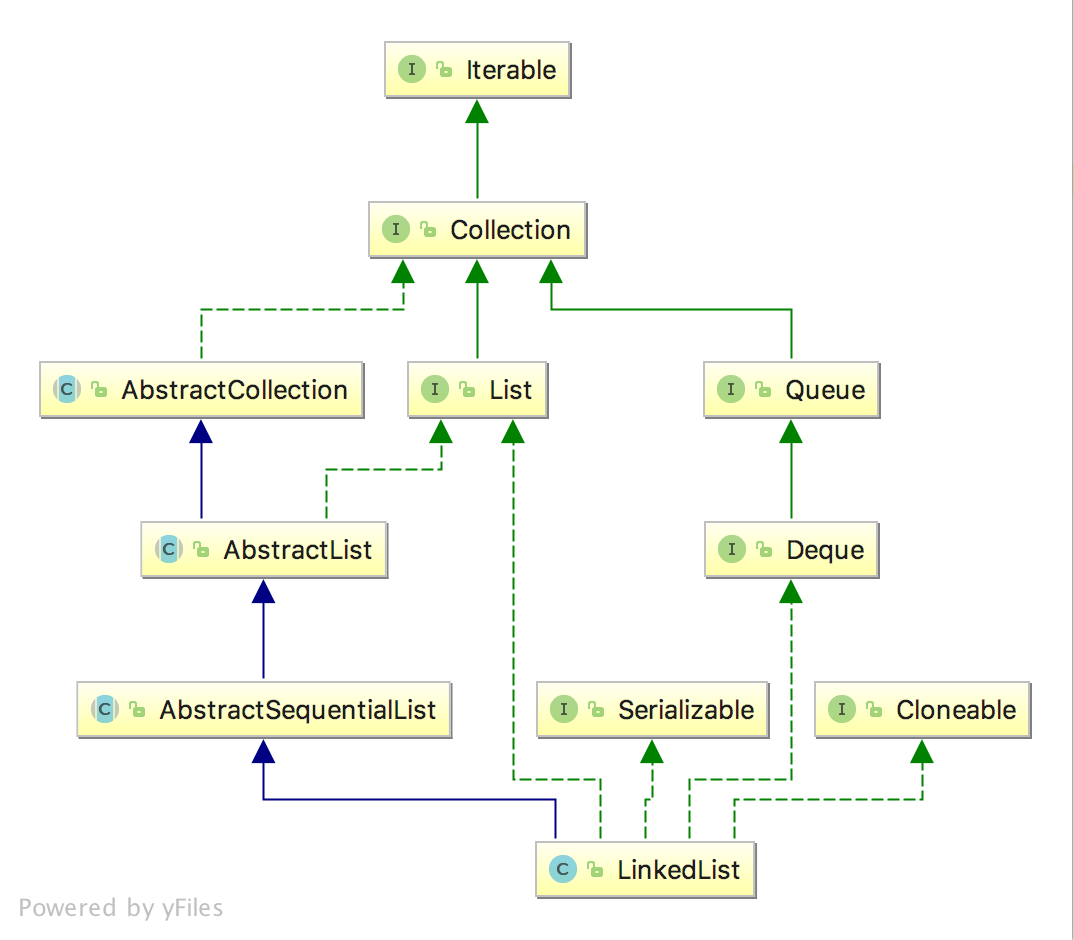java源码-LinkedList
开篇
LinkedList基于链表实现,在List中间进行插入和删除的代价较低,提供了优化的顺序访问。LinkedList在随机访问方面相对比较慢,但是它的特性集较ArrayList更大。
LinkedList的实现是一个双向链表,LinkedList存储的Node节点包含指向前置后置节点的指针。
LinkedList类图


LinkedList类定义
LinkedList的类定义中包含first节点和last节点,通过first节点(指向头节点)和last节点(指向尾节点)将串联所有的list中的节点,看下Node的定义就知道了。
Node的prev和next节点分别指向前后节点。
public class LinkedList<E>
extends AbstractSequentialList<E>
implements List<E>, Deque<E>, Cloneable, java.io.Serializable
{
transient int size = 0;
// 指向LinkedList的第一个节点
transient Node<E> first;
// 指向LinkedList的最后一个节点
transient Node<E> last;
private static class Node<E> {
E item;
Node<E> next;
Node<E> prev;
Node(Node<E> prev, E element, Node<E> next) {
this.item = element;
this.next = next;
this.prev = prev;
}
}
}
LinkedList构造函数
LinkedList的构造函数非常简单,关键是看下参数为Collection的构造函数,在该构造函数当中通过addAll()方法将元素通过尾插入法添加到LinkedList当中。allAll参数的index标记从哪个位置开始插入。
public LinkedList() {
}
public LinkedList(Collection<? extends E> c) {
this();
addAll(c);
}
public boolean addAll(Collection<? extends E> c) {
return addAll(size, c);
}
public boolean addAll(int index, Collection<? extends E> c) {
// 确定是否超过index的下标
checkPositionIndex(index);
Object[] a = c.toArray();
int numNew = a.length;
if (numNew == 0)
return false;
// 确定插入位置的前后节点位置,pred是前置节点,succ是后置节点
Node<E> pred, succ;
if (index == size) {
succ = null;
pred = last;
} else {
succ = node(index);
pred = succ.prev;
}
// 直接采用链表插入法插入即可
for (Object o : a) {
@SuppressWarnings("unchecked") E e = (E) o;
Node<E> newNode = new Node<>(pred, e, null);
if (pred == null)
first = newNode;
else
pred.next = newNode;
pred = newNode;
}
if (succ == null) {
last = pred;
} else {
pred.next = succ;
succ.prev = pred;
}
size += numNew;
modCount++;
return true;
}
LinkedList常用操作
LinkedList的add方法
LinkedList的add()方法其实非常简单,就是在LinkedList的尾部进行插入,然后更新last节点就可以了。
public boolean add(E e) {
linkLast(e);
return true;
}
// 在尾部插入新的值
void linkLast(E e) {
final Node<E> l = last;
final Node<E> newNode = new Node<>(l, e, null);
last = newNode;
if (l == null)
first = newNode;
else
l.next = newNode;
size++;
modCount++;
}
public void add(int index, E element) {
checkPositionIndex(index);
if (index == size)
linkLast(element);
else
linkBefore(element, node(index));
}
// 设计巧妙,力求最少时间定为索引位置
Node<E> node(int index) {
// assert isElementIndex(index);
if (index < (size >> 1)) {
Node<E> x = first;
for (int i = 0; i < index; i++)
x = x.next;
return x;
} else {
Node<E> x = last;
for (int i = size - 1; i > index; i--)
x = x.prev;
return x;
}
}
// 在合适的节点之前插入
void linkBefore(E e, Node<E> succ) {
// assert succ != null;
final Node<E> pred = succ.prev;
final Node<E> newNode = new Node<>(pred, e, succ);
succ.prev = newNode;
if (pred == null)
first = newNode;
else
pred.next = newNode;
size++;
modCount++;
}
LinkedList的remove方法
LinkedList的remove()的方法也非常简单,通过移除头部节点即可,然后将first节点后移即可。
public E remove() {
return removeFirst();
}
public E removeFirst() {
final Node<E> f = first;
if (f == null)
throw new NoSuchElementException();
return unlinkFirst(f);
}
private E unlinkFirst(Node<E> f) {
// assert f == first && f != null;
final E element = f.item;
final Node<E> next = f.next;
f.item = null;
f.next = null; // help GC
first = next;
if (next == null)
last = null;
else
next.prev = null;
size--;
modCount++;
return element;
}
LinkedList的indexOf方法
LinkedList的indexOf()方法主要从first到last进行遍历依次比较即可。
public int indexOf(Object o) {
int index = 0;
if (o == null) {
for (Node<E> x = first; x != null; x = x.next) {
if (x.item == null)
return index;
index++;
}
} else {
for (Node<E> x = first; x != null; x = x.next) {
if (o.equals(x.item))
return index;
index++;
}
}
return -1;
}
LinkedList迭代器
LinkedList的迭代器主要分为两个:
- iterator主要是在AbstractList类中定义,通过java的多态性调用LinkedList的size()方法和get()方法实现索引的比较和数据的获取等。
- listIterator在LinkedList类中实现,通过index指定迭代器开始遍历的位置,通过前后指针进行next移动,通过index和size比较是否遍历完成。
public Iterator<E> iterator() {
return new Itr();
}
private class Itr implements Iterator<E> {
int cursor = 0;
int lastRet = -1;
int expectedModCount = modCount;
// 调用LinkedList的size()方法
public boolean hasNext() {
return cursor != size();
}
public E next() {
checkForComodification();
try {
int i = cursor;
// get()方法调用的是LinkedList的方法
E next = get(i);
lastRet = i;
cursor = i + 1;
return next;
} catch (IndexOutOfBoundsException e) {
checkForComodification();
throw new NoSuchElementException();
}
}
}
public ListIterator<E> listIterator(int index) {
checkPositionIndex(index);
return new ListItr(index);
}
private class ListItr implements ListIterator<E> {
private Node<E> lastReturned;
private Node<E> next;
private int nextIndex;
private int expectedModCount = modCount;
ListItr(int index) {
// assert isPositionIndex(index);
next = (index == size) ? null : node(index);
nextIndex = index;
}
public boolean hasNext() {
return nextIndex < size;
}
public E next() {
checkForComodification();
if (!hasNext())
throw new NoSuchElementException();
lastReturned = next;
next = next.next;
nextIndex++;
return lastReturned.item;
}
}




